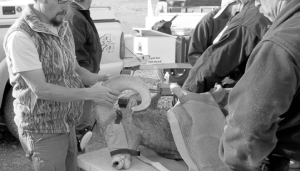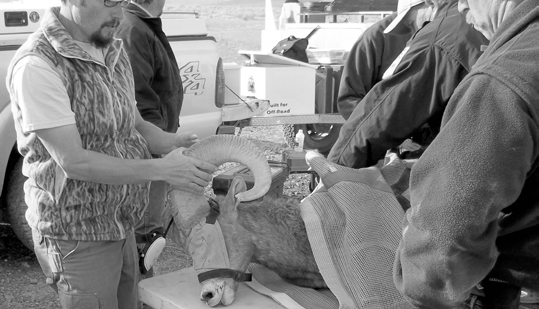
The ground crew was ready to jump into action as the sheep, slung under the helicopter, were gently laid on the ground. As soon as they landed, they were released them from the helicopter and carried over to a scale to be weighed. The bighorn then they were then laid on a table where the NDOW wildlife veterinarian and biologists began their biological inspections and sampling. The safety, comfort, and health of the sheep was of utmost importance during the time they were away from there herd. All activities were overseen by the Nevada Department of Wildlife NDOW wildlife veterinarian, Dr. Peri Wolff.
The project was to conduct disease surveillance and monitor movements of the rams among the herds that exist in Mineral and Esmeralda Counties. Prevalence of potentially deadly pathogens was one of their main objectives. Of the ten herds that make up the large metapopulation of bighorn sheep in Mineral and Esmeralda Counties, the primary pathogen of concern, Mycoplasma ovipneumoniae, has already been detected in three of the herds. The concern is this pathogen may be spread to other herds by wandering bighorns, likely young rams. It is unknown at this time how the pathogen was initially transmitted to these bighorn herds. The disease surveillance goal is to inventory all ten herds in the metapopulation for the presence of certain pathogens, compare to adult survival and lamb recruitment in each herd and better understand the potential spread of the pathogens among the herds by the natural movement of bighorns.
They send a thank you to all the sportsmen’s groups for always being there when help is needed, and for the past and present financial support from the Wildlife Heritage Fund, Board of Wildlife Commissioners, and local and national sportsmen’s organizations to fund bighorn management projects. Also special thanks to our NDOW Game Division employees, the local members and volunteers of sportsman clubs, and the County Advisory Boards to Manage Wildlife for their dedication and passion in big game restoration and improving our knowledge to help make future efforts even that much more effective and successful.


